|
The Lotus Eleven that rolled out for the motoring press
debut early in
February 1956 was different from all
the other cars that followed. It was different enough to cause years of
confusion and debate among Lotus researchers. The photographers gathered
that day at Alexandra Palace in London included Louis Klemantaski, and each
had ample opportunity to capture the car from every angle and get
close-ups of every detail. It was fortunate that they examined it so
well because three months later it was probably shunted beyond
recognition, and the ensuing rebuild changed the features that made it
unique. This essay is about the short life and significance of what has since been
called: the Press Car.
For February 10th 1956, the cover of AutoSport
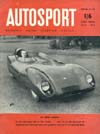 announced the new Lotus Eleven to the
world. Other automotive weekly magazines, Autocar
and the Motor also ran articles describing the car,
each quoting the same specifications, and to some extent the same
phrases that probably came from Colin Chapman himself. This Lotus Eleven
was painted, while others at the Lotus shop at Hornsey would be sent to
their new owners in raw aluminum. But many more important details of
this car differed from all subsequent models. The single-skin doors,
inner front fenders attached to the frame instead of the bonnet,
unfinished dash panel and missing headlamp covers all indicate a rushed assembly as well as its prototype status mentioned in the texts.
But there was an engineering oddity visible in the photos: a unique rear
suspension layout that differed from the description given in the
articles.
announced the new Lotus Eleven to the
world. Other automotive weekly magazines, Autocar
and the Motor also ran articles describing the car,
each quoting the same specifications, and to some extent the same
phrases that probably came from Colin Chapman himself. This Lotus Eleven
was painted, while others at the Lotus shop at Hornsey would be sent to
their new owners in raw aluminum. But many more important details of
this car differed from all subsequent models. The single-skin doors,
inner front fenders attached to the frame instead of the bonnet,
unfinished dash panel and missing headlamp covers all indicate a rushed assembly as well as its prototype status mentioned in the texts.
But there was an engineering oddity visible in the photos: a unique rear
suspension layout that differed from the description given in the
articles.
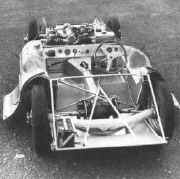 Each of the weeklies described the rear suspension as having been
developed from the Mk 9. Each described twin parallel radius arms used to locate the
deDion tube front to rear, with lateral location made with a short diagonal
brace angled to give the effect of a much longer Panhard rod.
But the photos in the Autosport story show a single radius
arm on each side and a strange, full-width, curved arm attached to the
sides of the chassis and the center of the DeDion tube. There was no
explanation for the discrepancy.
Each of the weeklies described the rear suspension as having been
developed from the Mk 9. Each described twin parallel radius arms used to locate the
deDion tube front to rear, with lateral location made with a short diagonal
brace angled to give the effect of a much longer Panhard rod.
But the photos in the Autosport story show a single radius
arm on each side and a strange, full-width, curved arm attached to the
sides of the chassis and the center of the DeDion tube. There was no
explanation for the discrepancy.
Another early article about the Eleven had an interesting revelation. MOTOR
RACING, in 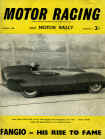 its March 1956 issue, featured the Press
Car (with Chapman driving) on its cover and a full page of details
inside. As Graham Capel once noted, “Motor Racing was
a monthly publication, unlike the previous weeklies and could not get
into print as quickly with hot news.” But consider that Motor
Racing may have also been given a look at the car in advance of the
other magazines, in view of its delayed publication. Its photos
weren’t taken at Alexandra Palace but at Hornsey. Instead of a garden
setting we see canvas tarps as background and what was undoubtedly the
inside of the recently constructed assembly building for the Eleven. Motor
Racing had two different photos of the rear suspension arrangement,
and this is where they had an exclusive. (For a
reprint of this article, click the 'cover' at left.)
its March 1956 issue, featured the Press
Car (with Chapman driving) on its cover and a full page of details
inside. As Graham Capel once noted, “Motor Racing was
a monthly publication, unlike the previous weeklies and could not get
into print as quickly with hot news.” But consider that Motor
Racing may have also been given a look at the car in advance of the
other magazines, in view of its delayed publication. Its photos
weren’t taken at Alexandra Palace but at Hornsey. Instead of a garden
setting we see canvas tarps as background and what was undoubtedly the
inside of the recently constructed assembly building for the Eleven. Motor
Racing had two different photos of the rear suspension arrangement,
and this is where they had an exclusive. (For a
reprint of this article, click the 'cover' at left.)
The text of the article notes that: The deDion tube is located by
three tubular radius arms, two of which are parallel fore and aft but
the third forms a semi-circle at the rear of the chassis. Colin Chapman
has had second thoughts about this as will be seen in the captions to
the photographs. The caption of the first deDion photo, showing the
curved arm, states: The curved prototype locating arm, just visible,
will be superceded by a method illustrated on page 77.
Then, on the second photo we see: Finalised DeDion layout for
the Lotus Mk XI. . . . And this is the 'conventional' layout the
other magazines described, but seen only on a bare chassis.
Perhaps the reporter had more of an opportunity to enquire about the curved
arm than the others did at the press gathering, or that Chapman needed to explain why a different design was also in the shop.
This was a stage in development where each Eleven being built had
something unique in its chassis or suspension, and comparisons were
being made. Three of the first cars would soon be put on a ship for the
USA, to give the car its race debut at the Sebring 12 hour, and to bring
some needed sales and cashflow. Another would be sold as a kit for Jabby
Crombac to build. Through February and March production would be at full
speed to get the Eleven program moving in the UK, and it was imperative
that the design be finalized. The mention of “second thoughts” about
the suspension in early February suggests that Chapman had already
tested this car against another.
The first batch of production chassis, as many as ten, had
provision for mounting the curved locating arm in reinforced holes at
the sides of the seatback bulkhead. But they also had brackets for
mounting the straight upper and lower radius arms. Perhaps the Press
Car lacked the necessary brackets needed to equip it like the others
and, as it was already paneled, welding in the brackets wasn't
practical. Something, perhaps
the desire to do more testing, prevented it from being 'standardized.' It took four decades for the outside world to know
it, but this was the only Lotus Eleven ever equipped with the curved
locating rod.
We get another good glimpse of the Press Car in Jabby Crombac’s
biography, Colin 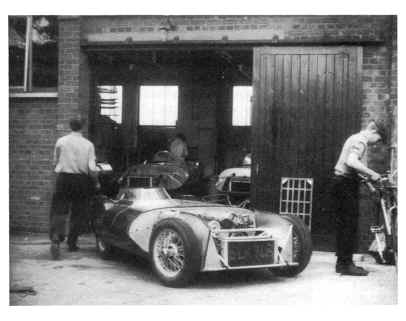 Chapman. On page 65 we see it emerging
from the shop, with Chapman rushing around. The bonnet is off and we
have a clear view of its unique prototype inner fenders. Three siblings
are in the background of the photo, still undergoing assembly, and a
bare chassis is on the floor. Barely
visible, a registration number SLK 7(?)8, is scrawled on the radiator.
This would be Mark Fitzalan-Howard’s car, who bought it,
registered as SLK 748, in April. Factory records show the second
Lotus Eleven being sold to Howard, and that was chassis no.151. Chapman. On page 65 we see it emerging
from the shop, with Chapman rushing around. The bonnet is off and we
have a clear view of its unique prototype inner fenders. Three siblings
are in the background of the photo, still undergoing assembly, and a
bare chassis is on the floor. Barely
visible, a registration number SLK 7(?)8, is scrawled on the radiator.
This would be Mark Fitzalan-Howard’s car, who bought it,
registered as SLK 748, in April. Factory records show the second
Lotus Eleven being sold to Howard, and that was chassis no.151.
Some have suggested that 151 was to have been Chapman’s personal car,
and this would have made it the 'works' car, with the often-used
registration 9 EHX. It's an interesting notion, in light of Chapman usually setting his own
car’s specification to a higher standard than the others he sold.
Perhaps, early on, the curved arm was thought to be an advantage worthy
of exclusive development. Some of the first cars to race in the UK,
notably those of Allison and Bicknell, had the normal rear suspension
arrangement, and they suffered from handling problems. Chapman is
supposed to have found a quick cure for this, and it was probably just a matter of not enough caster angle. But Chapman’s 9 EHX was also
reported to have had handling problems, and if it was chassis no.151, he
dealt with it by getting rid of the car.
Over the next thirty-five years speculation rambled on about what had
become of the Press Car, and where were the other early Elevens
with curved locating rods? It was thought that the car Chapman tried to
race at Sebring had one because of the large clearance scoop visible in the
undertray, clearly revealed when co-driver Len Bastrup rolled the car
in front of photographers. It
was also thought that the Press Car had been the first Eleven,
the prototype, and that upon finding a curved location rod in an Eleven
the discoverer could shout “eureka!” and claimed to have found it.
In all the international discussion no one ever seemed to suspect the
Fitzalan-Howard car, perhaps because it soon vanished from the record.
A first-hand account on the Fitzalan-Howard car finally came from Dave
Kelsey, founder of Progress Chassis and, as someone who built the
frames, who certainly knew his Elevens. Kelsey wrote the letter below to
the Historic Lotus Register late in 1992.
Some of his more
illuminating remarks are highlighted here.
“In the HLR magazine, you
raise the question of the ex-works Elevens. Well, one Climax car was
sold to Mark Fitzalan-Howard and Maurice Baring in bits, and Sid Marler
and I assembled it for them in Mark’s garage in Cadogan Mews, behind
his parents’ house in Eaton Place. I can’t remember why it was in
bits, but probably Chapman had removed anything useful before selling
it.
“On completion of the Eleven, Mark arranged for a test day at Goodwood
in company with the leather Connolly brothers and their father, and
Maurice Baring, and we trooped off in convoy - the Connollys’
Westminster, the Eleven driven by Mark, Maurice’s brand new Aston
DB2-4, and my Ford Thames van. I distinctly remember passing one
unsuspecting victim on both sides, with my van and the Lotus on the
grass on one side, and the Westminster and Aston on the other.
“I had to stop for petrol on the way, and when I arrived at Goodwood,
I drove to the track just in time to hear a howl and a shriek as Mark
stuffed the Eleven into the chicane on his first lap. He did very little
damage, and I straightened out the track rods and pulled away the
bodywork ready to go again. I was sitting in the car, engine running,
about to start my first lap when the Duke of Richmond, who owned the
circuit, appeared, and said “you aren’t planning to drive that, are
you?” The upshot was that he refused to let us use the full circuit,
but agreed to allow standing start quarter miles, until the car had been
back to the works for a check. (I don’t know who he thought would
check it, if not me.)
“Sid, Maurice, Mark, and the Connollys all thrashed the car up the
straight on timed sprints, and it became immediately apparent that Mark
and Maurice had very little idea of racing gear-changing, achieving
times in the 20 second range. Sid and I took full advantage of the A30
gearbox and simply snapped through the gears without lifting off,
getting down to 16 seconds or so. Having exhausted the possibilities of
sprinting, we adjourned to Maurice’s superb pad in Godalming for tea,
where I left my van, taking Maurice’s Aston back to Hornsey for Bill
Griffiths to perform some magic on the carbs.
“The next move was to book Brands Hatch for further testing, and
having done nothing more to the car than I did at Goodwood, Mark,
Maurice, Sid and I started lapping in turn, each doing about five laps
before handing over. Mark and Maurice had their own contest, and Sid and
I vied for fastest lap around the 60 second area. (On the short circuit,
I hasten to add.)
“The car had a de Dion
rear, with, I think, a Watts link and single radius arms, and I found it
an absolute pig to drive.
The discs locked up at a touch, and even a judicious application of oil,
as recommended by Colin (who was on the scene) failed to even them out.
The main problem arose on the straight, which then had a hump which
prevented any sight of Paddock Bend until you were almost on top of it. Unfortunately,
the Eleven had the most excruciating rear-end steering when you lifted
off after heavy acceleration, and I found it a struggle to keep it on
the road.
“There were two choices - lift off well before Paddock, so as to get
it sorted before committing to the corner, or press on with fingers
crossed and teeth gritted in the hope that you would still be on the
tarmac at the approach to the corner. The former meant that when you
reached Paddock, the car was not going fast enough to drift properly,
and you were in danger of going off on the inside of the bend, while the
latter required more changes of trousers than I had catered for.
“As five o’clock and closure of the circuit approached, I was in the
lead on lap times 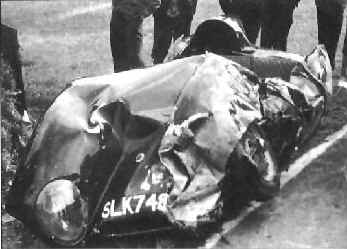 with 59 seconds, and Sid was set for a final attempt.
He came out of Clearways for the last time, selected second gear instead
of top at 105 mph, lost it,
and shunted the only thing there was to hit on the straight, a
marshal’s bunker. Sid popped out through the cockpit opening like a
pip out of an orange, did about the same number of cartwheels as the
car, and came to rest with a broken pelvis and sundry bruises. The car
did not fare so well, only the hubcaps remaining in their original form. with 59 seconds, and Sid was set for a final attempt.
He came out of Clearways for the last time, selected second gear instead
of top at 105 mph, lost it,
and shunted the only thing there was to hit on the straight, a
marshal’s bunker. Sid popped out through the cockpit opening like a
pip out of an orange, did about the same number of cartwheels as the
car, and came to rest with a broken pelvis and sundry bruises. The car
did not fare so well, only the hubcaps remaining in their original form.
“Eventually, the car bodywork was repaired in rudimentary fashion by
Norman Burgess, in London Colney, and even more eventually, I rebuilt
the rest, taking the opportunity to replace the rear suspension
with a twin radius arm and Panhard rod set-up in the hope of making it
more stable.”
The crash photo suggests two things: that Sid Marler was lucky
to escape with his life, and that a rebuild of this car must have been
total. Combined with this letter it adds evidence that the
Fitzalan-Howard car, SLK 748, was the Press Car. Several other
photos of the wreckage show details that match unique details of the car
photographed at Alexandra’s Palace. The fact that Kelsey and others
reassembled and finished a car the factory had sold in bits may explain
any other details that don’t match. And tellingly, Kelsey’s
characterization of the suspension as having a “Watts link” must be from his recollection of a central mount to the
deDion tube, because nothing else in a typical Eleven would suggest
this.
In selling this car to Fitzalan-Howard, especially in kit or disassembled form,
Lotus could be suspected of trying to bury a mistake. (Or is this too
cynical?) Kelsey once told Victor Thomas of the HLR that he had
negotiated the deal on the car between Chapman and F-H in April. It says
something for this car to have been surplus and disassembled at a time when the
factory was rushing to fill orders. Fitzalan-Howard was
not known for being able to race, and even though he reappeared in the
rebuilt SLK 748 by June of ’57, he never seemed to have any luck with
it. That August the car was
wrecked again, this time by Maurice Baring. Early in 1958 Fitzalan-Howard
and Baring took delivery of a Series-2 Eleven, and their S-1, the Press
Car disappears. Perhaps it was never repaired from the last shunt.
To this day it still hasn’t been found.
If Kelsey was correct in his diagnosis of rear-steer, the layout of the
curved locating rod and single (as opposed to two on each side) trailing
arm suspension would appear to have allowed the hub assemblies to twist
or yaw as forces (ie. throttle) changed. Under racing conditions it would
take less than one degree of change in rear-toe to cause a wicked rear-steer effect.
We know that Chapman later devised a controlled rear-steer in his
Formula 1 suspensions, where the outside rear wheel would toe-in under
spring compression. This carefully calculated effect might have been an
outgrowth of the discovery of unintentional steer in the earlier design.
It is food for thought.
Typical of Chapman, who at times could be stubborn with his ideas, a similar
full-width
lower control link with single upper radius
arms appeared years later in the series 2 and 3 versions of the Seven.
Here a single A-frame, pivoted from the seatback sides, was
connected to the bottom center of the rear axle through a bracket.
However, this method of axle location also proved troublesome.
Early owners soon discovered that these axles had never been designed for the
the stresses introduced by this fitment so oil leaks and more serious
complications could arise. Welded reinforcements to the axle were
soon added. Granted, the live axle of the Seven must absorb torque forces
not shared with a deDion tube. But
one may suppose that if the sturdy, live axle casings of the
Seven can distort under loading, the lightweight deDion tube on the Press
Car had little chance of always keeping the wheels pointed straight.
In the solution used on all subsequent Lotus Elevens (and ironically
also the Seven S-1) the deDion is located with two radius arms on each
side, with one of them incorporating a single diagonal tube forming an
A-frame to secure the axle laterally.
The diagonal tube and radius arms all direct their lines of force
near to where the hub bearings reside, thereby sparing the deDion tube from the
twists and stress of a centrally mounted bracket load.
Still, cracking of the deDion tube was a common problem, and the
Eleven series-2 was improved with one of larger diameter for this
reason. Also, Vic Thomas has drawn attention to the S-2 hub casting
having two integral “ears” for attachment to the radius arms. After
proofreading this essay he noted, “The hub casting for the series 1
has a single top locating ear only, which is no doubt testimony to the
fact that Chapman ordered 300 castings based on his original design.
This is overcome in practice by welding a pickup point to the bottom
endpoints of the deDion tube itself, a fault rectified by the series 2
casting.”
Despite its problems, the Press Car was pretty to look at when
new and did its job in front of the cameras well enough to be remembered
by Lotus Eleven aficionados ever since.
Its flaws were turning points in the embryonic development of
Lotus’ first major success.
|